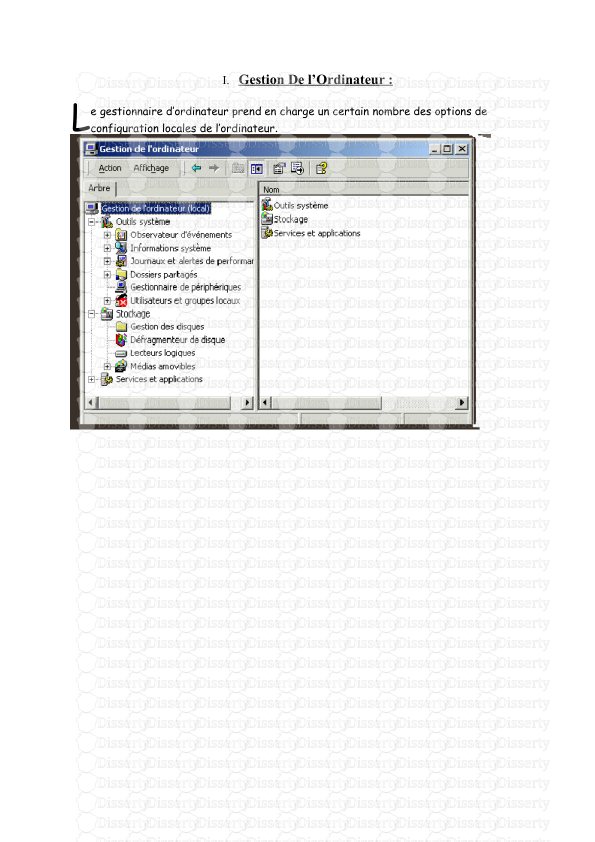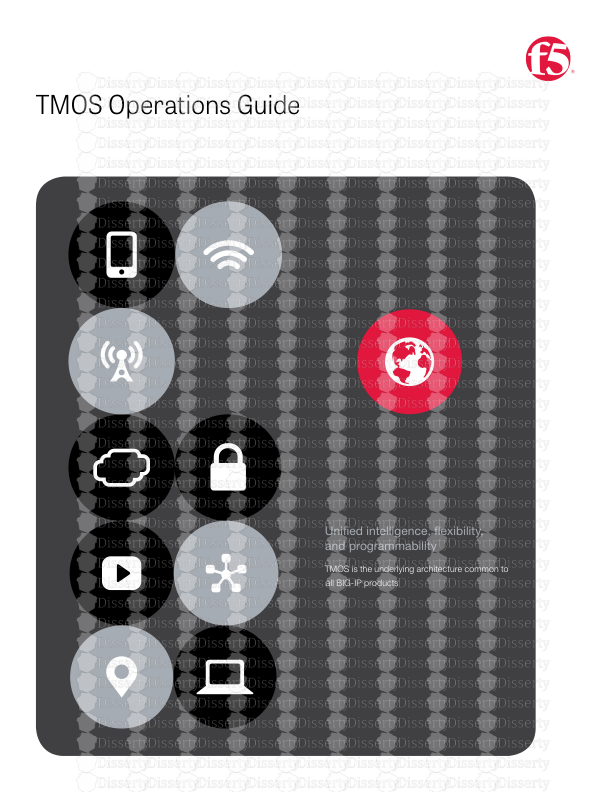TMOS Operations Guide TMOS is the underlying architecture common to all BIG-IP
TMOS Operations Guide TMOS is the underlying architecture common to all BIG-IP products Unified intelligence, flexibility, and programmability i CONTENTS— Contents Quick Start Guides viii Maintenance at a glance viii Maintenance checklist xiii Upgrade checklist xiv Upgrade tasks reporting (BIG-IP 13.x and later) xiv About This Guide 1 Before using this guide 1 Limits of this guide 1 Glossary 2 Customization 2 Issue escalation 2 Feedback and notifications 3 Configuration utility 3 Command-line syntax 3 Finding other documents 4 BIG-IP iHealth 5 At a glance–Recommendations 5 Background 5 Additional resources 9 Operating Environment 10 At a glance–Recommendations 10 Background 10 Procedures 11 Additional resources 14 Hardware Diagnostics 16 At a glance–Recommendations 16 Background 16 Procedures 17 Additional resources 26 ii CONTENTS— VIPRION 28 At a glance–Recommendations 28 Background 28 Procedures 33 Additional resources 44 Drive Maintenance 45 At a glance–Recommendations 45 Background 45 Procedures 51 Additional resources 55 Licenses and Entitlement 57 At a glance–Recommendations 57 Background 57 Procedures 58 Additional resources 66 Backup and Data Recovery 67 At a glance–Recommendations 67 Background 67 Procedures 73 Additional resources 84 Software Updates 85 At a glance–Recommendations 85 Background 85 Procedures 85 Additional resources 95 Networking and Cluster Health 96 At a glance–Recommendations 96 Background 96 Local Authentication Fallback 100 Procedures 104 Troubleshooting enhancements (BIG-IP 13.x and later) 112 Additional resources 114 iii CONTENTS— Log Files and Alerts 115 At a glance–Recommendations 115 Background 115 Procedures 120 Additional resources 130 Modules 132 At a glance–Recommendations 132 Background 132 Procedures 142 Additional resources 145 MySQL 146 Background 146 Additional resources 147 Caches 148 At a glance–Recommendations 148 Procedures 150 Additional resources 155 External APIs 156 At a glance–Recommendations 156 Background 156 Procedures 160 Additional resources 166 Security 167 At a glance–Recommendations 167 Background 167 Procedures 174 Additional resources 174 Optimizing the Support Experience 176 F5 technical support commitment 176 F5 certification 177 Self-help 178 iv CONTENTS— F5 training programs and education 181 Engage F5 Support 181 Appendix A: Outside the Box 192 Front panel characteristics 192 Back panel characteristics 195 VIPRION chassis characteristics 196 Appendix B: Deployment and Response Methodologies 199 At a glance–Recommendations 199 Background 199 Appendix C: Support Incident Report 209 Support Incident Report 209 Opening a Support Case 210 Legal Notices 211 Trademarks 211 Patents 211 Notice 211 Publication Date 212 Copyright 212 Change List 213 v FIGURES— Figures Figure 0.1: F5 documentation coverage 2 Figure 11.1: BIG-IP objects configured for remote high-speed logging 124 Figure A.1: BIG-IP 5000 series platform front panel 192 Figure A.2: LCD panel on a BIG-IP 7000 series application delivery controller 194 Figure A.3: BIG-IP 5000 series platform back panel 195 Figure A.4: BIG-IP 7000 series platform back panel 196 Figure A.5: BIG-IP 10000 series platform back panel 196 Figure A.6: VIPRION 4800 Platform chassis components 197 Figure A.7: VIPRION B4300 blade components 198 vi TABLES— Tables Table 0.1 Command-line syntax 3 Table 1.1 Quick information bar items 6 Table 1.2 Areas of the BIG-IP iHealth Status > Overview page 7 Table 1.3 Additional iHealth resources 9 Table 2.1 General platform environmental operating specifications 11 Table 2.2 Additional Operational Environment Resources 14 Table 3.1 File types available for EUD download 19 Table 3.2 Possible tasks with downloaded EUD files 21 Table 3.3 Options for running EUD tests 22 Table 3.4 EUD test suite 22 Table 3.5 EUD options 25 Table 3.6 Additional hardware diagnostics resources 26 Table 4.1 LED indicators for chassis standard operating states 29 Table 4.2 LED indicators for blade standard operating states 30 Table 4.3 Additional VIPRION resources 44 Table 5.1 Logging and error conditions 50 Table 5.2 Additional drive maintenance resources 55 Table 6.1 Additional licensing and entitlement resources 66 Table 7.1 Default UCS archive encryption values 74 Table 7.2 Additional backup and data recovery resources 84 vii TABLES— Table 8.1 Additional software updates resources 95 Table 9.1 Ntpq command returns 110 Table 9.2 Additional networking and cluster health resources 114 Table 10.1 Log information categories and their descriptions 117 Table 10.2 Available facilities 119 Table 10.3 Emerg level report messages 120 Table 10.4 Description of high-speed logging configuration objects 124 Table 10.5 MCP logging levels 125 Table 10.6 tmsh logging levels 126 Table 10.7 Additional log files and alerts resources 130 Table 11.1 Recommended maintenance for BIG-IP APM 135 Table 11.2 Recommended maintenance for BIG-IP ASM 135 Table 11.3 Additional modules resources 145 Table 12.1 Additional MySQL resources 147 Table 13.1 Additional caches resources 155 Table 14.1 Additional external APIs resources 166 Table 15.1 Additional security resources 174 Table B.1 Articles to assist with assembling your support case 210 Quick Start Guides These quick start guides are intended to help you hit the ground running if you need to quickly prepare for maintenance of your BIG-IP® system investment. The guides include the following sections: • Maintenance at a glance, which compiles the recommendations and breaks them down by frequency and location of the procedures and background information in this document. They also provide a few external references. • Maintenance checklist, which offers a set of tasks to help prepare for your BIG-IP maintenance periods. • BIG-IP upgrade checklist, which provides a set of recommended tasks for preparing for BIG-IP upgrades. There may be additional activities and tasks required by your company policies or industry standards that you want to add to these lists. Important These guides are intended to supplement your current business and systems operations and requirements. They are not intended to replace them. Maintenance at a glance One-time tasks Description Refer to chapter Notes Ensure system is mounted according to the relevant platform guide. “Operating Environment” Platform guides are available by searching AskF5™ (support.f5.com). Ensure the BIG-IP system synchronizes its clock with a network time protocol (NTP) server. “Networking and Cluster Health” You can use the NTPQ command to monitor NTP activity. For more information, refer to AskF5 article K10240: Verifying NTP peer server communications Configure logging to remote log servers. “Log Files and Alerts” If you use centralized logging, ensure that you set the correct time and time zone on the device. Configure SNMP traps. “Log Files and Alerts” Set up a second power supply if your system has only one power supply. “Operating Environment” Not all platforms support multiple power supplies. Applies only to 1600, 2000, 3600, 4000, and 5000 series. Connect redundant power supplies to two separate power sources in your data center. “Operating Environment” Subscribe to F5® TechNews and security mailing lists. “Software Updates” or “Optimizing the Support Experience” Refer to AskF5 Publication Preference Center (interact.f5.com/technews.html). viii QUICK START GUIDES—Maintenance at a glance One-time tasks Description Refer to chapter Notes Become familiar with the initial baseline performance of your system. F5 recommends that you create a baseline for purposes of tracking performance changes over time. Also refer to the F5 Product Datasheets page. (f5. com/resources/datasheets). Baseline data is offered for informational purposes and may not reflect the performance of your implementation. Daily tasks Description Refer to chapter Notes Check available log files for messages pertaining to system stability and health. “Log Files and Alerts” Review log files to identify and prevent excessive logging. “Log Files and Alerts” Check debug modes to identify excessive logging and lower log rotation rate. “Log Files and Alerts” Monitor the system (SNMP, iControl®, script) for rapid increases in connections per second. “Networking and Cluster Health” Monitoring activity can identify possible Distributed Denial-of-Service (DDoS) attacks. F5 recommends sending data to an external monitoring system that can trigger alerts when values rise rapidly. Weekly tasks Description Refer to chapter Notes Upload a QKView file to iHealth®. “BIG-IP iHealth” BIG-IP iHealth (ihealth.f5.com) Check available disk space. “Drive Maintenance” Check for software updates. “Software Updates” BIG-IP system versions 11.5 and later include an automatic update check feature. For more information, refer to AskF5 article: K15000: Using the Automatic Update Check feature. All BIG-IP system software can be obtained from F5 Downloads (downloads.f5.com). Check cache use. “Caches” ix QUICK START GUIDES—Maintenance at a glance Twice-monthly tasks Description Refer to chapter Notes Audit console messages to review logged messages. “Networking and Cluster Health” Check neighbor routing table entries. “Networking and Cluster Health” Complete this task if you are using your BIG-IP system as a router. Monthly tasks Description Refer to chapter Notes Create a UCS archive and move to a storage repository. “Backup and Data Recovery” Perform BIG-IP system change management review. “Backup and Data Recovery” Check for OPSWAT updates. “Modules” Check for attack signature updates. “Modules” Review attack signature and policy settings. “Modules” Quarterly tasks Description Refer to chapter Notes Review iHealth trends. “BIG-IP iHealth” BIG-IP iHealth (ihealth.f5.com) Uploaded qkview data is deleted after three months. F5 recommends you back up and save this data to review trends over longer periods of time. Track data center and system temperatures as part of your review of BIG-IP iHealth qkview data. “Operating Environment” x QUICK START GUIDES—Maintenance at a glance Twice-yearly tasks Description Refer to chapter Notes Complete facilities review: • Verify ground lugs are attached to solid earth ground. • Evaluate current and projected needs uploads/s1/ f5-tmos-operations-guide.pdf
Documents similaires










-
41
-
0
-
0
Licence et utilisation
Gratuit pour un usage personnel Attribution requise- Détails
- Publié le Mar 10, 2021
- Catégorie Administration
- Langue French
- Taille du fichier 1.2710MB


